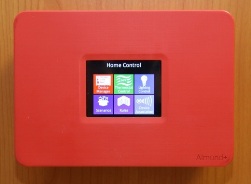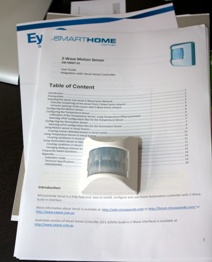Categories: Featured Articles » Home automation
Number of views: 13765
Comments on the article: 0
Z-Wave smart home system: first introduction
 If you collect all those offered today on the Internet smart home systems and standards in one place, you will have to urgently measure IQ (amount of intelligence) and decide who is the boss in the house. Modern products Z-Wave standard such a procedure will definitely not hurt.
If you collect all those offered today on the Internet smart home systems and standards in one place, you will have to urgently measure IQ (amount of intelligence) and decide who is the boss in the house. Modern products Z-Wave standard such a procedure will definitely not hurt.
The created alliance, or open consortium, to support the new standard impresses with its composition: from the world leader in the production of Intel chips to the world electrical leader Danfoss A / S. And among 200 members of the consortium, Panasonic, Logitech, and dozens of well-known companies, often fiercely competing with each other, “were modestly lost”.
What led them all to a modest market niche (or abode) home automation? To answer this question, let's take a closer look at the very concept of the Z-Wave standard and its prospects. The technology was developed at the beginning of the 21st century by the small company Zensys, which is now part of Sigma Designs.
 Basis Z-Wave Technology laid the principle of fishing net (mesh - net) with cells ranging in size from 10 to 30 meters.
Basis Z-Wave Technology laid the principle of fishing net (mesh - net) with cells ranging in size from 10 to 30 meters.
The devices are located in the nodes of the cells and are micropower transceivers operating at a frequency of approximately 900 MHz.
For different regions, the frequency varies depending on the laws of countries in the field of radio frequencies. For Russia, Germany and most CIS countries, the allowed frequency is 869.0 MHz. The power of the device in transmitter mode does not exceed 1 mW.
Nodal devices play a dual role: they are either executive end blocks or simple signal repeaters.
The ability to relay commands allows you to transmit commands through a chain of devices at a distance of up to 300 meters from the command console with a radius of action of an individual device up to 30 meters.
The system provides completely wireless communication between control and executive devices with the ability to confirm (acknowledge) the received commands.
The last property is very important, because in case of a failure in signal transmission and lack of confirmation, the command is retransmitted with the ability to change the route.
 This approach provides flexibility in the system, the ability to scale (expand) the system to 232 devices.
This approach provides flexibility in the system, the ability to scale (expand) the system to 232 devices.
Another interesting feature is the independent operation of two or more Z-Wave systems within one platform.
Each of the systems receives its own special identification number and control signals in one system do not interfere with the work of the others. This approach allows the consumer to choose to build: either several separate subsystems, or one complex system controlled by a computer.
Since each device can transmit information about its state, and this is very rare in simple automation systems, it becomes possible to build complex control scenarios using conditional transitions without the participation of a central console or computer.
For building automated home load management systems High qualification is not needed - the devices are offered in a functionally finished form, and installation requires only a screwdriver and care when reading the instructions.
The basis for building Z-Wave devices is a specialized controller chip from two manufacturers: Sigma Designs and Mitsumi. In the finished blocks, the ZW0201, or newer ZW0301, SD3402 chips are equipped with the necessary parts for transmitting radio signals.
Separate devices are additionally equipped with a memory chip for storing commands, signal transmission routes, and other information entered by the user when configuring the system.
The functional composition of devices that support the Z-Wave standard already impresses with diversity: it includes socket modules for controlling light and other electrical appliances, modules for interfacing with USB cords, gateways for accessing local Ethernet or Internet networks, mobile and stationary control panels .
 Products are currently manufactured by several different companies, and their number is constantly growing. The compatibility of devices among themselves is checked in certification centers and problems on this side should not be feared.
Products are currently manufactured by several different companies, and their number is constantly growing. The compatibility of devices among themselves is checked in certification centers and problems on this side should not be feared.
The most painful issue when meeting a new standard is the price of automation devices. A pleasant surprise awaits us here.
Despite the modern elemental base, and maybe, thanks to it, solid functionality, the price of the device lies in the range of hundreds of dollars. But this is not the limit. Since Chinese manufacturers are clearly not included in the list of the consortium, we can expect, with their appearance in this market segment, a sharp collapse in prices. And it is not customary for the Asian neighbor to swing for a long time.
There are spots in the sun, and this standard has a drawback, or rather, a weak spot. Most Z-Wave modules are powered by an independent power source: AAA finger batteries.
According to the manufacturer, their resource is enough for a year of operation. But already the first users of devices of this standard were faced with the need to change power supplies every quarter. The reason is not only the low quality of the galvanic cells entering the CIS market, but also miscalculations of consumers in setting the operating modes of the units.
Therefore, to properly configure the system with Z-Wave blocks, contrary to the assurances of the manufacturers, knowledge, and even better, experience in the field of home automation will not hurt. And proprietary software is called to help in this fascinating occupation. It is designed to configure systems, especially three-dimensional, including 30-80 devices.
And now back to the question of why these huge corporations became interested in modest home automation. The answer is trivial: money and great flair. The saturation of home appliances and the presence in almost every family of a computer opens up exciting prospects for the implementation of hundreds of millions of diverse devices. And companies do not intend to miss such a promising market.
See also at bgv.electricianexp.com
:
